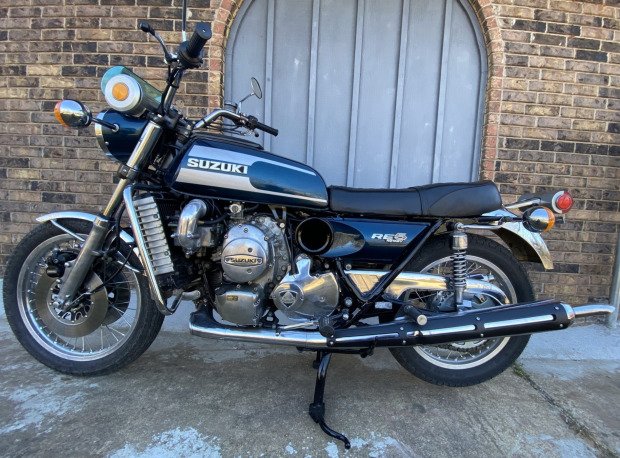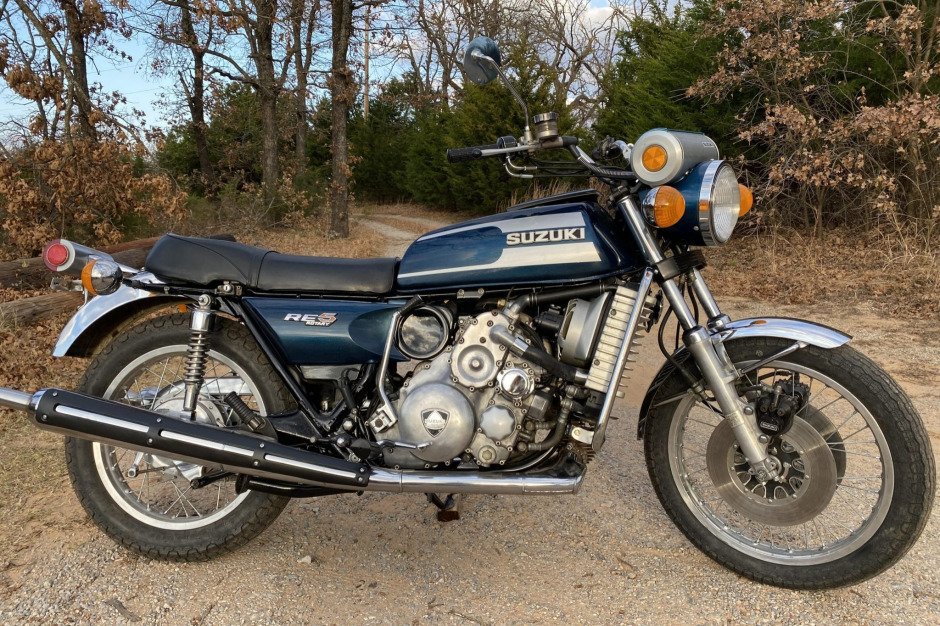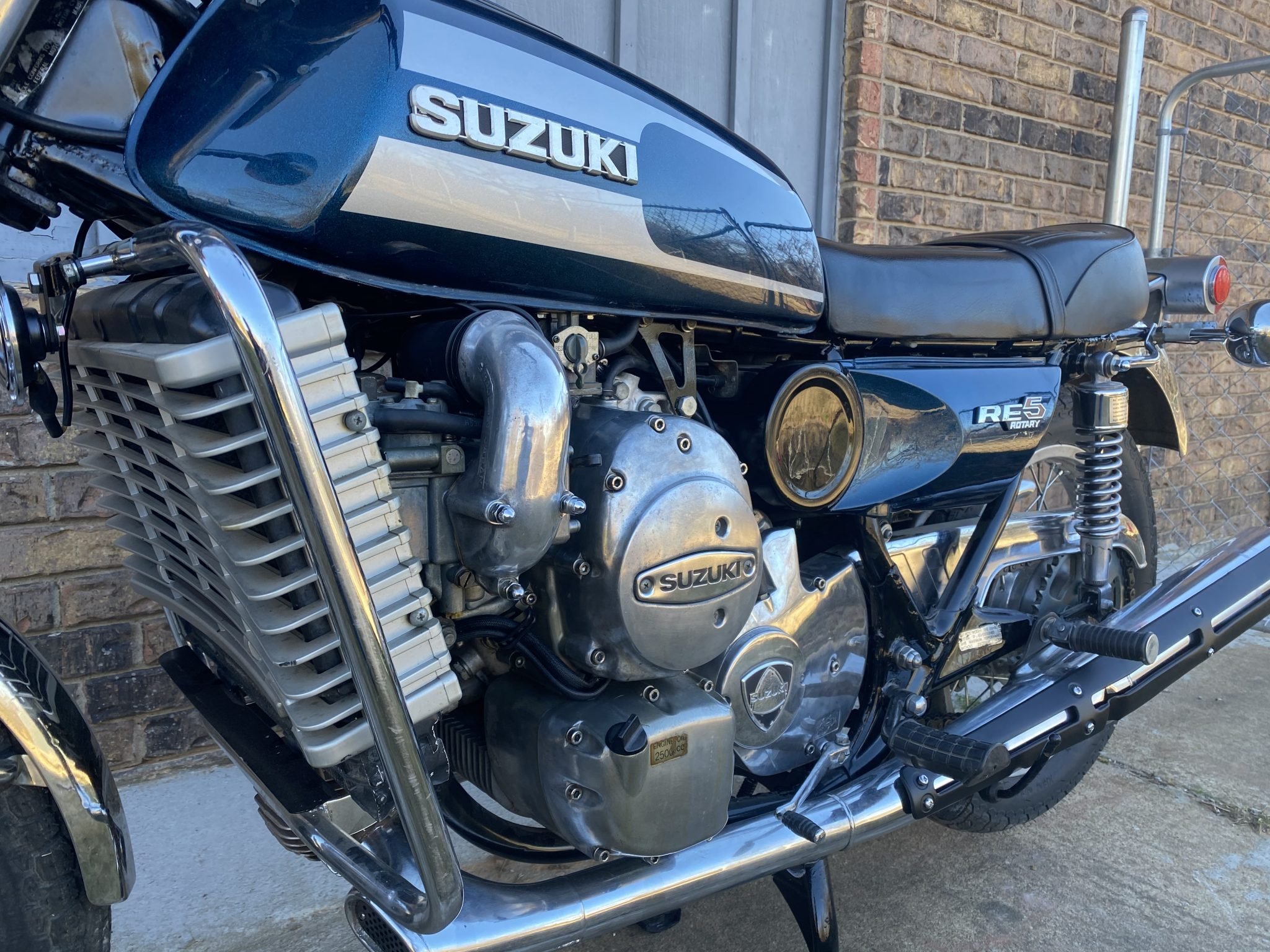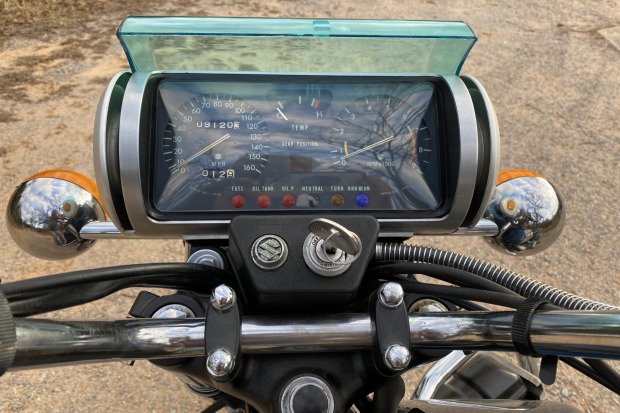1975 Suzuki RE5 Wankel Rotary




First Japanese production motorcycle with rotary engine
Styled by Georgetto Guigiaro
Single multi-stage carburetor
Liquid and Oil Cooling
The Suzuki RE-5 represents the only Japanese production motorcycle to utilize a Wankel rotary engine for its powerplant. The Wankel engine provides smooth and high revving power in a relatively compact engine and does so with a minimal number of moving parts as compared to a 4-cycle piston engine. While the engine excels in power efficiency, its downside is heat and fuel economy. The 500cc Wankel Engine used in the RE-5 uses both water and oil cooling along with a single dual-throat carburetor to create a linear power delivery geared towards touring and distance riding.
Developed first as a supercharger pump back in the 1930s by German engineer Felix Wankel and later as a complete power plant, rotary engines first found a home for industrial use. It was subsequently adapted for use in several German automobiles as early as 1964 and Japanese automobile manufacturer Mazda incorporated Wankel designed rotary engines for their 1967 Mazda Cosmo sports car and subsequently on RX series autos into the 1990’s. East German-based MZ offered the first real Wankel-powered motorcycle followed by Hercules motorcycles offering a Wankel engine bike in 1974. In the early 1970’s both Yamaha and Kawasaki (and presumably Honda) built prototype motorcycles with rotary engines but due to a variety of engineering issues, neither company brought their bikes into production. It was only after significant engineering attention to cooling the engine and exhaust, did Suzuki bring their radically designed RE-5 to the general public for sale.
The components offered on the RE-5 were unlike any previous motorcycle as the builder made every attempt to make the bike stand out on the dealer floor. Handlebar mounted gauges were housed in a cylindrical pod that had a protective shield that could be raised or lowered to protect the instruments as part of a design by Italian stylist Georgetto Guigiaro. A large chrome covered radiator placed in front of the engine highlighted the bike’s water cooling while substantial heat shields were placed over the exhaust manifold and chrome exhaust pipes to protect the rider’s legs from burns. The engine looked like no other motorcycle powerplant, having an industrial look with no visible exterior clues as to how it was powered. Even the exhaust note was radically different as the engine exhaust tone was more of a civilized “hum” than a throaty “roar”.
When the Suzuki RE-5 first appeared in dealerships in late 1974, it was a well-documented product release in the motorcycle press, praising the handling of the bike despite having a substantial weight. The new engine and bike styling came at a cost and the bike was priced well above motorcycles with similar performance. And while the bike hit the right notes on handling, the styling was not well liked, and poor sales forced Suzuki to tone down the look of the bike to become more mainstream. Complexity of systems became a concern, with 3 separate oil pumps, a unique Mikuni two stage downdraft carburetor, and points fired CDI ignition made servicing the bike by mechanics trained on traditional reciprocating piston engines problematic. Despite these drawbacks, the bike still churned out over 60hp in a 500cc package at a time where emissions concerns and engine power were being restricted by government and insurance companies.
The RE-5 shared a 5-speed manual transmission with Suzuki’s two-cycle GT-750 3 cylinder motorcycle and transmission lubrication was stored separately from the engine. Cooling the engine was a paramount concern as rotary engine exhaust temperatures could be as high as 1700 degrees Fahrenheit. Special dual lined exhaust pipes with cool air intake ducts were needed to dissipate the high heat and the bike used both water cooling for the engine cases and oil cooling for the combustion chamber with a separate oil and water radiators mounted behind the front suspension. The carburetor employed 5 different fuel and air circuits to accommodate the high revving engine and special ignition mapping was required to smooth engine power when the operator backed off the throttle as engine braking was minimal. To adequately slow the vehicle, Suzuki outfitted the RE-5 with dual disk front brakes also shared from the GT750.
Despite the styling changes, in 1976 sales languished for the RE-5 and Suzuki discontinued the model after only two years of production. While several other manufacturers such as Norton and Van Veen were to produce Wankel engine motorcycles in subsequent years, they too opted to move away from the rotary as emissions and fuel economy measures favored piston engines over the Wankel engine. The RE-5 stands alone as an example of a challenging engineering journey made by a mainstream manufacturer that pushed the envelope of accepted propulsion solutions.
Suzuki RE5 Specifications:
Engine: 497 cc single rotor Wankel oil and water-cooled engine; 5-speed manual transmission; dual-stage Mikuni carburetor, Capacitor Discharge Ignition w/ points
Frame: Steel dual downtube cradle frame, front and rear suspension, dual disk front brakes, single drum rear brake
Weight: 563lbs curb weight
Performance: 62 horsepower, standing ¼ mile 14.02 seconds at 94mph
Top Speed: 104 mph

